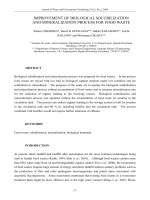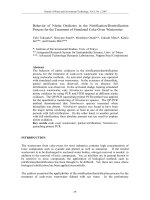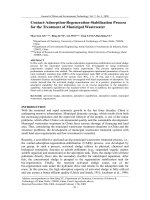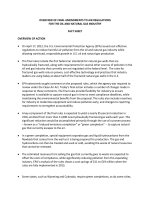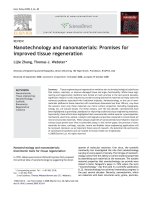Gas assisted gravity drainage (GAGD) process for improved oil recovery
Bạn đang xem bản rút gọn của tài liệu. Xem và tải ngay bản đầy đủ của tài liệu tại đây (385.62 KB, 11 trang )
IPTC 13244
Gas-Assisted Gravity Drainage (GAGD) Process for Improved Oil Recovery
Norollah Kasiri and A. Bashiri, Iran University of Science & Technology
Copyright 2009, International Petroleum Technology Conference
This paper was prepared for presentation at the International Petroleum Technology Conference held in Doha, Qatar, 7–9 December 2009.
This paper was selected for presentation by an IPTC Programme Committee following review of information contained in an abstract submitted by the author(s). Contents of the paper, as
presented, have not been reviewed by the International Petroleum Technology Conference and are subject to correction by the author(s). The material, as presented, does not necessarily
reflect any position of the International Petroleum Technology Conference, its officers, or members. Papers presented at IPTC are subject to publication review by Sponsor Society Committees
of IPTC. Electronic reproduction, distribution, or storage of any part of this paper for commercial purposes without the written consent of the International Petroleum Technology Conference is
prohibited. Permission to reproduce in print is restricted to an abstract of not more than 300 words; illustrations may not be copied. The abstract must contain conspicuous acknowledgment of
where and by whom the paper was presented. Write Librarian, IPTC, P.O. Box 833836, Richardson, TX 75083-3836, U.S.A., fax +1-972-952-9435.
ABSTRACT
Water Alternating Gas injection (WAG) or Simultaneous Water and Gas Injection (SWAG) floods have been proposed as
very good solution to overcome gravity segregation and better EOR performance in compare to conventional
continuous gas injection (CGI). However WAG-Based processes cause some problems associated with increased water
saturation including diminished gas injectivity. As an effective alternative for WAG, Gas Assisted Gravity Drainage
(GAGD) for conventional reservoirs has been developed (US Patent 2006/0289157) that takes advantage of the natural
segregation of gas from liquid hydrocarbon during injection. The GAGD process consists of placing a horizontal producer
near the bottom of oil column and injecting gas through existing vertical wells. As the injected gas rises to form a gas
zone, oil and water drain down to the horizontal producer. Application of GAGD for IOR in naturally fractured reservoir is
discussed here based on some facts and figures.
Xen kẽ nước Gas injection (WAG) hoặc đồng thời nước và Gas Injection (SWAG) lũ lụt đã được đề xuất
như là giải pháp rất tốt để vượt qua lực hấp dẫn phân biệt và hiệu suất tốt hơn EOR trong so sánh với
phun khí liên tục thông thường (CGI). Tuy nhiên quá trình WAG-Dựa gây ra một số vấn đề liên quan với
tăng độ bão hòa nước bao gồm injectivity khí giảm. Là một thay thế hiệu quả cho WAG, Gas Assisted
Trọng lực thoát nước (GAGD) cho các hồ chứa thông thường đã được phát triển (US Patent
2006/0289157) mà lợi dụng sự phân biệt tự nhiên của khí hydrocarbon lỏng từ khi tiêm. Quá trình
GAGD bao gồm việc đặt một nhà sản xuất ngang gần phía dưới của cột dầu và bơm khí đốt qua giếng
thẳng đứng hiện tại. Khi khí bơm tăng để tạo thành một khu vực khí đốt, dầu mỏ và thoát nước xuống
cho nhà sản xuất ngang. Áp dụng cho GAGD IOR trong hồ chứa tự nhiên bị gãy được thảo luận ở đây
dựa trên một số sự kiện và con số.
KEYWORDS: Gravity Drainage, Improved Oil Recovery, Fractured Reservoir, Simulation
1. INTRODUCTION
Worldwide EOR surveys by the Oil and Gas Journal (April 21, 2008) for the last two decades clearly shows increased
popularity and production share of gas injection processes in the world. Review of related experiences indicates
that sweep & microscopic displacement efficiency are major issues for any successful EOR Process. Microscopic
efficiency (as extent of mobilizing the trapped reservoir residual oil) is a function of capillary number (Ca) as ratio of
viscous to capillary forces. On the other hand, the volumetric sweep, defined as the percentage of reservoirs
contacted by the injected fluid, is governed by the mobility ratio and reservoir heterogeneity (Willhite et al., 1998):
Các cuộc điều tra trên toàn thế giới bởi EOR Dầu và Gas Journal (ngày 21 tháng tư năm 2008)
trong hai thập kỷ qua cho thấy rõ ràng tăng phổ biến và sản xuất phần của quá trình phun khí trên
thế giới. Tổng kết kinh nghiệm liên quan cho thấy quét & hiệu quả chuyển vi là vấn đề lớn đối với
bất kỳ trình EOR thành công. Hiệu quả vi (như mức độ huy động các hồ chứa bị bẫy dầu dư) là một
chức năng của số lượng mao mạch (Ca) là tỷ lệ nhớt để lực mao dẫn. Mặt khác, các quét thể tích,
định nghĩa là tỷ lệ phần trăm của các hồ chứa liên lạc với các chất lỏng được tiêm, được điều chỉnh
bởi tỷ lệ di động và hồ chứa không đồng nhất (Willhite et al., 1998):
µDνD
Ca =
σ
λD
M=
λd
λkl=
l
µl
(1)
(2)
(3)
IPTC 13244
3
To maximize efficiency of any EOR process, the capillary number should be maximized while minimizing the mobility ratio.
Gas injection EOR processes are excellent in microscopic displacement efficiencies due to small interfacial tension
developed between the injected gas and reservoir oil, which can be further decreased to zero during miscible
injection that boosts Capillary Number value. But volumetric sweep efficiency of these EOR processes is their major
shortcoming (Satter et al., 2008). Viscosity of commonly injected gases such as carbon dioxide and hydrocarbons is
about one-tenth of the reservoir fluids viscosities that will cause unfavorable mobility ratios and severe gas-oil gravity
segregation with large un-swept reservoir areas. Fortunately some forecasting tools such as viscous gravity number can be
used to evaluate this issue (Green et al., 2000). In order to improve sweep efficiency of Gas Injection Water Alternating
Gas (WAG) has been widely practiced with simultaneous decrease for injection gas requirements. Although conceptually
sound, the WAG process has not measured up to expectations as evidenced by the low (5–10%) recoveries observed in
59 field applications (Kulkarni et al., 2006). Imperfect mobility ratio improvements and increased mobile water saturation
that causes water shielding (the water films prevent oil and gas coming into direct contact and, for miscible gas injection,
delay the onset of miscibility) can justify this poor recovery within WAG Process. The drainage of oil under gravity
forces, either through gas cap expansion or by gas injection at the crest of the reservoir, has proven to be an efficient
gas injection method (with considerable corefloods and filed investigation) since it can reduce the residual oil saturation
to very low values. Recoveries as high as 85–95% OOIP (Original Oil in Place) have been reported in field tests and
nearly 100% recovery efficiencies have been observed in laboratory floods (Ren, 2002). Gravity stable gas injection
takes advantage of the density difference between injected gas and reservoir fluid that cause problems of poor sweep
efficiencies and gravity override in horizontal gas floods (such as WAG). This concept has been used in next
sections to introduce interesting EOR process within naturally fractured reservoir.
Để tối đa hóa hiệu quả của bất kỳ quá trình EOR, số mao mạch nên được tối đa trong khi giảm thiểu tỷ
lệ di động. Quy trình EOR phun khí là tuyệt vời trong hiệu suất chuyển vi do căng bề nhỏ phát triển giữa
khí tiêm và dầu chứa, mà có thể được giảm hơn nữa để không khi tiêm có thể trộn làm tăng mao Số giá
trị. Nhưng hiệu quả quét thể tích của các quá trình này EOR là thiếu sót lớn của họ (Satter et al, 2008.).
Độ nhớt của chất khí thường được tiêm như carbon dioxide và các hydrocarbon là khoảng một phần
mười của chất lỏng chứa nhớt mà sẽ gây ra tỷ lệ di động không thuận lợi và khí dầu trọng lực phân biệt
nghiêm trọng với khu vực hồ chứa un-quét lớn. May mắn thay một số công cụ dự báo như số trọng lực
nhớt có thể được sử dụng để đánh giá vấn đề này (Green et al., 2000). Để nâng cao hiệu quả quét của
khí phun nước Xen kẽ Gas (WAG) đã được thực hiện rộng rãi với mức giảm đồng thời cho các yêu cầu
khí tiêm. Mặc dù khái niệm âm thanh, quá trình WAG đã không đo theo mong đợi bằng chứng là (510%) phục hồi thấp quan sát trong 59 lĩnh vực ứng dụng (Kulkarni et al., 2006). Cải thiện tỷ lệ di động
không hoàn hảo và tăng độ bão hòa nước di động có gây ra che chắn nước (các bộ phim nước ngăn
chặn dầu khí tiếp xúc trực tiếp và dùng để tiêm khí trộn lẫn, trì hoãn sự khởi hòa trộn) có thể biện minh
cho việc phục hồi kém này trong vòng WAG Process. Hệ thống thoát nước của dầu thuộc lực lượng
trọng lực, hoặc thông qua việc mở rộng nắp xăng hoặc phun khí trên đỉnh của hồ chứa, đã được chứng
minh là một phương pháp phun khí hiệu quả (với corefloods đáng kể và nộp tra) vì nó có thể làm giảm
độ bão hòa dầu dư để giá trị rất thấp. Phục hồi cao như 85-95% OOIP (Original Oil in Place) đã được
báo cáo trong các thử nghiệm lĩnh vực và gần 100% hiệu quả phục hồi đã được quan sát thấy trong lũ
lụt trong phòng thí nghiệm (Ren, 2002). Trọng lực phun khí ổn định lợi dụng sự chênh lệch mật độ giữa
khí và chất lỏng tiêm chứa gây ra các vấn đề về hiệu suất quét nghèo và trọng lực đè trong lũ khí ngang
4
IPTC 13244
(như WAG). Khái niệm này đã được sử dụng trong các phần tiếp theo để giới thiệu quá trình EOR thú vị
trong hồ chứa tự nhiên bị gãy.
2. GAS–OIL GRAVITY DRAINAGE (GOG D) IN NFR
In naturally fractured reservoirs (NFR), the matrix which contains most of the oil is surrounded by a system of fractures of
very little volume but with permeabilities that are several orders of magnitude higher than that of the matrix (not for
all type of Fractured Reservoirs but Type II which is encountered in south of Iran frequently):
Trong vỉa bị nứt tự nhiên (NFR)các khối, trong đó có hầu hết lượng dầu được bao quanh bởi một hệ
thống cơ gãy xương rất ít thề tích nhưng với độ thấm rằng một số đơn đặt hàng của các cường độ cao
hơn so với các ma trận (không phải cho tất cả các loại hồ chứa bị vỡ nhưng Type II đó là gặp phải ở
phía nam của Iran thường xuyên):
Table1: Classification of Naturally Fractured Reservoir (Nar et al., 2006)
NFR TYPE
TYPE1
DEFINITION
Fractures provide essential porosity
and permeability
TYPE2
Fractures provide essential permeability
TYPE3
Fractures provide a
permeability assistance
EXAMPLES
Amal, Libya
Edison, California
Agha Jari,
Iran Haft kel,
Iran
Spraberry Trend Area, Texas
Kirkuk, Iraq
Dukhan,Quatar
In such reservoir it is difficult to apply pressure differential in the matrix to recover its oil content by conventional
displacement process because injected fluid simply flows through the fracture system bypassing the oil in the matrix.
However by introduction of gas into the fracture system such that the gas-oil contact (GOC) in the fracture system
becomes deeper than the GOC in the matrix, then a hydrostatic imbalance is created. The oil in the matrix above the
fracture GOC is surrounded by gas and is forced to drain downwards by virtue of its higher density ultimately into the
fracture oil rim. As the oil drains from the matrix it is replaced by gas and the oil collecting in the fracture system can
then be produced. This process is called gas-oil gravity drainage (GOGD). Figure1 shows mathematical framework for
gravity drainage from single block within a given fractured reservoir. Van Golf-Racht (1982) showed that gravity drainage
displacement of oil by gas will start only if the column of gas in the fracture (Hg) is higher than the threshold height
because in such displacement the capillary pressure has a negative effect on production and oil can be produced to the
extent that gravitational forces exceed capillary forces. The gravity segregation in a given naturally fractured reservoir is
highly affected by extent of capillary continuity between matrix blocks across fractures, and by the process of oil
reinfiltration from fractures to matrix blocks (Kleppe, 1996):
Trong hồ chứa như vậy, rất khó để áp dụng chênh lệch áp suất trong ma trận để khôi phục lại nội dung
của nó dầu do quá trình chuyển thông thường vì chất lỏng tiêm đơn giản là chảy qua các hệ thống đứt
gãy bỏ qua dầu trong ma trận. Tuy nhiên theo giới thiệu của khí vào các hệ thống đứt gãy như vậy mà
liên lạc khí-dầu (GOC) trong các hệ thống đứt gãy trở nên sâu sắc hơn so với GOC trong ma trận, sau
đó là một sự mất cân bằng thủy tĩnh được tạo ra. Dầu trong ma trận trên chỗ gãy GOC được bao quanh
bởi khí và buộc phải thoát xuống nhờ mật độ cao hơn của nó cuối cùng vào rim dầu gãy xương. Như
5
IPTC 13244
các cống rãnh dầu từ các ma trận nó được thay thế bởi khí và dầu thu thập trong các hệ thống đứt gãy
sau đó có thể được sản xuất. Quá trình này được gọi là hệ thống thoát nước trọng lực khí-dầu (GOGD).
Hình 1. lãm khuôn khổ toán học cho hệ thống thoát nước trọng lực từ khối duy nhất trong một hồ chứa
bị vỡ được. Văn Golf-Racht (1982) cho thấy thuyên thoát nghiêm trọng của dầu bằng khí sẽ chỉ bắt đầu
nếu các cột khí trong gãy xương (Hg) là cao hơn so với chiều cao ngưỡng vì trong thuyên như vậy áp
lực mao mạch có ảnh hưởng tiêu cực đến sản xuất và dầu có thể được sản xuất đến mức lực hấp dẫn
quá lực mao dẫn. Sự phân biệt về trọng lực trong một hồ chứa bị nứt tự nhiên đã cho là ảnh hưởng
mạnh mẽ bởi mức độ của mao mạch liên tục giữa các khối ma trận trên gãy xương, và do quá trình xâm
nhập ngược dầu từ gãy xương cho các khối ma trận (Kleppe, 1996):
Fig.1. Oil Displacement by Gas oil Gravity Drainage within Matrix Block of Fractured Reservoir
One of the very important issues in studying a given naturally fractured reservoir, regardless of simulation model
capabilities, is to investigate the presence and the degree of capillary continuity within reservoir structure (Refer to Fig. 2
for different possible fracture-matrix interaction). Some authors are advocating the presence of capillary continuity (BlockBlock Interaction) in fractured reservoir but their conclusion is mainly based on the results of superficial and simple
laboratory experiments or simulation observations (Saidi, 2006) which is not valid for actual reservoir simulation studies.
Một trong những vấn đề rất quan trọng trong việc nghiên cứu một hồ chứa bị nứt tự nhiên nhất định, bất kể khả
năng mô hình mô phỏng, là để điều tra sự hiện diện và mức độ của các mao mạch liên tục trong cấu trúc chứa (Tham
khảo Hình. 2 cho khác nhau có thể tương tác gãy-matrix). Một số tác giả đang ủng hộ sự hiện diện của mao mạch liên
tục (Block-Block Interaction) trong hồ chứa bị vỡ nhưng kết luận của họ chủ yếu dựa trên các kết quả của các thí
nghiệm trong phòng thí nghiệm hời hợt và đơn giản hoặc quan sát mô phỏng (Saidi, 2006) là không hợp lệ cho
nghiên cứu mô phỏng hồ thực tế .
Fig.2. Schematic Representation of Different Types of Matrix-Fracture Interaction (Saidi, 1987)
For example if fair to good capillary continuity exists between blocks, repressurizing a fractured reservoir by gas injection
would mainly give the swelling benefit of the residual oil saturation. Whereas if poor capillary continuity exists in a
reservoir, gas repressurizing will considerably improve oil recovery throughout both swelling and reducing interfacial
tension and thus the threshold height of matrix. The presence and degree of capillary continuity can be estimated by
analyzing the variation of oil production rate versus the variation of oil column thickness or the variation of gas-oil
contact within a given reservoir (Saidi, 1987). Also if the horizontal fractures are partially filled with impermeable
materials then a poor capillary continuity should be expected. Therefore confirmation of capillary continuity (and its extent)
within a given fracture reservoir is more important than its mathematical modeling.
An important aspect in gas-oil gravity drainage of fractured reservoirs (with direct impact on gravity drainage and
EOR processes such as gas assisted gravity drainage) is reinfiltration process when drained oil from an upper matrix block
enters (totally or partially) into lower one (Fig.2). The flow from one block to another (reinfiltration) is either achieved by film
flow across contact points or by liquid bridges. The reinfiltration mechanism is also time dependent, since liquid bridging
provides the main transmissibility in the initial stage of the gravity drainage process. Later the oil saturation in the fractures
will be very low and the main liquid transmissibility from block to block is due to film flow. This final period is of long
duration and is very important for the overall recovery. Therefore EOR process in NFR such as Gas Assisted Gravity
Drainage (GAGD) that refers to gravity drainage as main recovery mechanism should pay attention to mathematical
modeling of these complex reservoirs.
3. GAS ASSISTED GRAVITY DRAINAGE IN NATURALLY FRACTURED RESERVOIR
The newly proposed Gas Assisted Gravity Drainage (GAGD) process (Rao et al., 2008) provide a process which
extrapolates the highly successful gravity stable gas injection processes. The GAGD process consists of placing a
horizontal producer at the bottom of the pay zone and injecting gas through existing vertical wells at the top (into the
gas cap) to provide gravity stable displacement and uniform reservoir sweep. This process takes advantage of the
gravity segregation effects and horizontal wells technology for different types of reservoirs. Horizontal wells have the
advantage of having a high productivity index (due to large contact with the reservoir). Furthermore, horizontal wells are
ideal for the gravity drainage processes (Rao et al, 2004). The main advantage of placing the horizontal well at the
bottom of the pay zone in GAGD is that when the natural drive of oil such as gas cap or solution drive has been
depleted, gravity forces will take over with continued oil production. A second advantage of horizontal wells is that they
able to delay gas breakthrough and the encroachment of water:
Các khí mới được đề xuất hỗ trợ trọng lực thoát nước (GAGD) quá trình (Rao et al., 2008) cung cấp
một quá trình mà extrapolates trọng lực ổn định quá trình phun khí rất thành công. Quá trình GAGD bao
gồm việc đặt một nhà sản xuất ngang phía dưới của vùng lương và tiêm chích khí thông qua giếng
thẳng đứng hiện ở đầu (vào nắp gas) để cung cấp cho lực hấp dẫn di dời ổn định và thống nhất quét hồ
chứa. Quá trình này mất lợi thế của hiệu ứng trọng lực phân biệt và giếng ngang công nghệ với nhiều
loại khác nhau của hồ chứa. Giếng ngang có lợi thế của việc có một số năng suất cao (do tiếp xúc lớn
với các hồ chứa). Hơn nữa, giếng ngang rất lý tưởng cho các quá trình thoát nước trọng lực (Rao et al,
2004). Ưu điểm chính của việc đặt cũng ngang phía dưới của vùng lương trong GAGD là khi ổ đĩa tự
nhiên của dầu như nắp xăng hoặc ổ đĩa giải pháp đã bị cạn kiệt, lực lượng trọng lực sẽ đi qua với sản
lượng dầu tiếp. Một lợi thế thứ hai của giếng ngang là họ có thể trì hoãn đột phá khí và xâm lấn của
nước:
Fig. 3: Schematic of Gas Assisted Gravity Drainage Process (US Patent 2006/0289157)
The only published experimental data (immiscible Injection) related to GAGD within a simple fractured core with only
two vertical fractures (Mahmoud et al., 2007) have been checked here with an in-house numerical code for fractured
reservoir simulation. Due to nature of the code which is developed for well-fractured reservoir and estimation of some data
that was not reported for mentioned fractured core it is interesting that good agreement is available between
predicted and actual data. Regardless of simulation results and refer to experimental trend within this example (Fig. 4)
and importance of gas-oil gravity drainage within NFR as major recovery mechanism it can be stated that GAGD
should be considered as competitive IOR candidate for naturally fractured reservoir with deep oil column. Kulkarni et al.
(2006) introduced a new dimensionless group as "gravity Drainage Number" with corresponding approximate correlations
for GAGD oil recovery (miscible and immiscible) based on some 2D physical model, 1D Core Floods and 3D Filed data:
Các dữ liệu thực nghiệm chỉ được công bố (tiêm immiscible) liên quan đến GAGD trong một lõi gãy đơn
giản chỉ với hai vết nứt thẳng đứng (Mahmoud et al., 2007) đã được kiểm tra ở đây với một mã số trong
nhà cho mô phỏng hồ chứa bị vỡ. Do tính chất của mã được phát triển cho hồ chứa cũng bị gãy và ước
của một số dữ liệu đã không được báo cáo cho đề cập lõi gãy nó là thú vị rằng thỏa thuận tốt có sẵn dữ
liệu giữa dự đoán và thực tế. Bất kể kết quả mô phỏng và tham khảo xu hướng thử nghiệm trong ví dụ
này (Hình. 4) và tầm quan trọng của hệ thống thoát nước trọng lực khí-dầu trong NFR như cơ chế thu
hồi lớn có thể khẳng định rằng GAGD nên được coi là cạnh tranh ứng cử viên IOR cho hồ chứa tự
nhiên bị gãy với sâu cột dầu. Kulkarni et al. (2006) đã giới thiệu một nhóm thứ nguyên mới như "lực hấp
dẫn thoát nước Number" với tương quan tương ứng để thu hồi dầu GAGD (có thể trộn và immiscible)
dựa trên một số mô hình vật lý 2D, 1D lõi Lũ lụt và 3D Nộp dữ liệu:
q (N¢ + NB)]
g
+N[GD = NG o
q
(4)
Where NB (Bond Number) measures the relative strength of gravity and capillary forces and NG is a combination of the bond
& capillary number. Structure of NGD indicate that k (absolute permeability) is solely source of difference for NGD value
between
fractured and conventional reservoirs. In this basis and because fractured reservoir can have higher absolute permeability
than conventional one (generally), experimental data in Fig. 4 become reasonable. Also refer to approximate correlations
(Equation
7 & 8) and definition of gravity drainage number it can be said that miscible GAGD can yield better overall recovery in
fractured reservoir due to small interfacial tension (near zero) developed between injected gas and reservoir fluid in this
condition that boosts Capillary Number and Bond Number values.
Nơi NB (Bond Number) đo sức mạnh tương đối của trọng lực và lực lượng mao mạch và NG là một sự
kết hợp của số trái phiếu và mao mạch. Cấu trúc của NGD chỉ ra rằng k (độ thấm tuyệt đối) là nguồn
gốc của sự khác biệt cho NGD giá trị giữa các hồ chứa bị vỡ và thông thường chỉ. Trong cơ sở này và
vì hồ chứa bị vỡ có thể có độ thấm tuyệt đối cao hơn so với một quy ước (nói chung), dữ liệu thử
nghiệm trong hình. 4 trở nên hợp lý. Cũng đề cập đến mối tương quan gần đúng (Equation7 & 8) và
định nghĩa của số lượng thoát nước trọng lực có thể nói rằng GAGD thể trộn có thể mang lại sự phục
hồi tổng thể tốt hơn trong hồ chứa bị vỡ do sự căng thẳng nhỏ bề (gần bằng không) phát triển hệ giữa
khí tiêm và chất lỏng chứa trong điều kiện này mao mạch làm tăng số lượng và Bond Số giá trị.
NB
=
NG
=
Δqg
k
( )
$
oog
(5)
k
Δqg ( )
$
µor
(6)
d
Rimmiscib1e (%) = 4.59 ln(NGD) + 32.3
(7)
Rmiscib1e (%) = 4.57 ln(NGD) + 55.39
(8)
100
90
80
Rec
% 70
Fra ctured Core Experimental
Fra ctured Core Simulati on Unfra ctured Core
60
50
20
40
10
30
0
0
50
100150200
Recovery, min
250
300
Fig. 4: Numerical and Experimental Prediction of GAGD within a simple fractured core (Core Data from Mahmoud et al., 2007)
4. CONCLUSION
Application of Gas Assisted Gravity Drainage (GAGD) within Naturally Fractured Reservoirs (NFR) has been
discussed in this paper. It can be stated that miscible GAGD process within a given fractured reservoir should offer
better recovery in compare to immiscible one but relative density of injection gas and reservoir fluid is another issue
that should be treated carefully during injection gas selection.
Ứng dụng của khí hỗ trợ trọng lực thoát nước (GAGD) trong hồ chứa tự nhiên bị gãy (NFR) đã
được thảo luận trong bài viết này. Có thể nói rằng quá trình GAGD thể trộn lẫn trong một hồ chứa bị
vỡ cho nên cung cấp phục hồi tốt hơn trong so sánh với một immiscible nhưng mật độ tương đối
của khí phun và chất lỏng chứa một vấn đề khác cần được điều trị cẩn thận trong quá trình lựa
chọn gas tiêm.
NOMENCLATURE
Ca: Capillary Number
λD: Mobility of the displacing fluid
phase λd: Mobility of the
displaced fluid phase λl: Mobility
of the fluid
kl : Effective Permeability of Phase l, mD
µl: Visocity of Phase l,
Pas. sec σ: Interfacial
Tention, N/m
ν: Darcy Velocity, m/sec
M: Mobility Ratio, Dimensionless
µD: Displacing Fluid Viscosity, Pas. Sec
REFERENCES
Christensen, J. R., Stenby, E. H., Skauge, A., 2001.Review of the WAG field experience, SPE Reservoir Evaluation & Engineering
(SPE 71203), Vol. 4, No. 2: 97-106
Chugh, S., Baker, R., Cooper, L., Steven, S., 2000.Simulation of Horizontal Wells to Mitigate Miscible Solvent Gravity Override
in the Virginal Hills Margin, Journal of Canadian Petroleum Technology, Vol. 39, No.2: 28-34
Fung, L.S-K., 1991.Simulation of Block-to-Block Processes in Naturally Fractured Reservoirs", SPE Reservoir Engineering, Vol. 6, No.
4: 477-484
Fung, L.S-K, 1993.Numerical Simulation of Naturally Fractured Reservoirs, SPE 25616, Middle East Oil Show, Society of
Petroleum Engineers, Bahrain, pp. 203-213
Green, D.W., Willhite, G.P., 1998.Enhanced Oil Recovery, SPE, Texas, USA, 545 pp.
Kleppe, J., Uleberg, K., 1996. Dual Porosity, Dual Permeability Formulation for Fractured Reservoir Simulation, Norwegian University of
Science and Technology (NTNU), Trondheim RUTH Seminar, Stavanger
Kulkarni, M. M., Rao, D.N., 2006. Characterization of Operative Mechanisms in Gravity Drainage Field Projects through Dimensional
Analysis, SPE 103230, SPE Annual Technical Conference and Exhibition, San Antonio, Texas, USA,
Mahmoud, T.N., Rao, D.N., 2007.Mechanisms and Performance Demonstration of the Gas-Assisted Gravity Drainage Process Using
Visual Models, SPE 110132, SPE Annual Technology Conference and Exhibition, California, USA
Narr, W., Schechter, D.W., Thompson, L.B., 2006.Naturally Fractured Reservoir Characterization, Society of Petroleum Engineers,
Texas, USA, 112 pp.
Rao, D.N., Sharma, A.P., 2008. Scaled Physical Model Experiments to Characterize the Gas-Assisted Gravity Drainage EOR Process,
SPE 113424, SPE/DOE Symposium on Improved Oil Recovery, Oklahoma, USA
Rao, D. N., Ayirala, S. C., Kulkarni, M.M., Sharma, A. P., 2004.Development of the Gas Assisted Gravity Drainage (GAGD) Process for
Improved Light Oil Recovery”, SPE 89357, SPE/DOE Fourteenth Symposium on Improved Oil Recovery, Tulsa, Oklahoma, USA
Ren, W., 2002.Application of the Gravity Assisted Tertiary Gas Injection Process, M.Sc. Thesis, University of Alberta, Edmonton,
Canada, 2002
Saidi, A.M., 2006. Status of Dual Porosity Reservoir simulation and expected features of a new rigorous model, Technical Presentation,
Petroleum Engineering and Development Company, Tehran-Iran
Saidi, A.M., 1987. Reservoir Engineering of Fractured Reservoirs, TOTAL Edition press, 864 pp.
Satter, A., Bushwalter, J.L., Lgbal, G.M., 2008.Practical Enhanced Reservoir Engineering: Assisted with Simulation Software, PennWell
Corporation, Tulsa, Oklahoma, USA, 706 pp.
Van Golf-Racht, T.D., 1982.Fundamentals of Fractured Reservoir Engineering, Elsevier Scientific Publishing Company, New York, USA,
710 pp.

